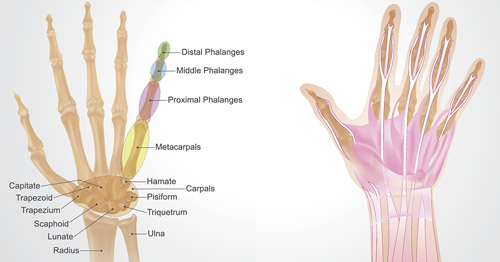Arthritis of the Hand and Wrist
Arthritis is inflammation in a joint. Several forms of arthritis affect the joints in the wrist, hand and fingers. Osteoarthritis is a degenerative condition in which cartilage wears down over time. Rheumatoid arthritis and psoriatic arthritis are systemic, inflammatory diseases. Rheumatoid arthritis is the most common type to affect the fingers, except for the thumb. Thumb arthritis is usually a form of osteoarthritis.
- Anatomy of the hand and wrist
- Hand and wrist arthritis overview
- Prevention of hand and wrist arthritis
- Treatments for hand and wrist arthritis
Anatomy of the hand and wrist
Hand anatomy
Your hand contains 19 bones (not including those that form the wrist). There are 14 phalanges, the bones that make up each finger: three in each of the index, middle, ring, and pinky fingers and two in the thumb. There are also five metacarpal bones that make up the middle part of the hand.
Numerous ligaments connect the bones to each other. Tendons connect muscles in the arm or hand to the bone to enable you to move your fingers. Sheaths are tubular structures that surround part of the fingers. There are thousands of nerve endings in your fingertips. Arteries, veins, and nerves provide essential blood flow and sensation in the hand and fingers.
Wrist anatomy
The wrist is one of the most complicated joints in the body. It contains eight bones called carpals, which are arranged in two rows. The scaphoid, lunate, triquetral and pisiform bones move with the arm bones, and the trapezium, trapezoid, capitate, and hamate bones are connected to the bones of the palm.
The carpal bones are connected by ligaments. Many tendons connecting the forearm muscles to the fingers and thumb run through the wrist. Extensor tendons on the back of the wrist straighten your fingers, while flexor tendons on the front of the wrist bend them. Nerves and blood vessels also pass through the wrist. These structures provide your wrist with exceptional range of motion.

Hand and wrist arthritis overview
Pain and stiffness are the most common signs of wrist arthritis. These symptoms, and the swelling associated, with arthritis can severely reduce the range of motion in joints (the normal distance joints can move in certain directions).
Learn more about hand and wrist arthritis and related conditions in the articles below.
Prevention of hand and wrist arthritis
Since osteoarthritis is caused by using a joint over time, it can be helpful to find ways to reduce the amount of stress you put on your wrist in your daily routines. For example, a person who cooks a lot may benefit from using a drying rack to let their washed pots air dry, rather than drying them with a cloth.
There are many devices can help with this effort. Learn how assistive technology can help prevent arthritis or alleviate arthritis symptoms in the wrists, hands and fingers in the article below.
Treatments for hand and wrist arthritis
Arthritis in the hands or wrist – as well as additional conditions it can cause, such carpal tunnel syndrome and trigger finger – may require physical therapy, medication and/or surgery to alleviate pain and stiffness.
Does exercise help hand and wrist arthritis?
Exercise, as part of a comprehensive arthritis treatment plan, can improve joint mobility, muscle strength, and overall physical conditioning, and it can also help you maintain a healthy weight. A tailored exercise program guided by a physical therapist can help relieve pain and fatigue and preserve joint structure and function. People with hand or wrist arthritis often avoid physical activity because of pain, but doing so can lead to muscle loss and excessive weight gain, and these can cause other health problems.
Is physical therapy for hand and wrist arthritis effective?
Although medication is one part of treatment for people with arthritis, a tailored exercise program can help relieve pain and fatigue and preserve joint structure and function.
What medications are effective for hand and wrist arthritis?
Over-the-counter (nonprescription) NSAIDs (nonsteroidal anti-inflammatory drugs), which include aspirin, ibuprofen and naproxen, are the most common drugs.
Does glucosamine help hand and wrist arthritis?
Glucosamine, with or without chondroitin sulfate, does appear to have some affect on the inflammatory response caused by arthritic degeneration in joints, specifically in the knees. Unfortunately, glucosamine has not been shown to slow or repair degeneration in articular cartilage. For this reason, no specific recommendation for the use of glucosamine, with or without chondroitin sulfate, can be made.
What is the surgery for hand and wrist arthritis?
When neither physical therapy nor medications are sufficient to treat hand or wrist arthritis, surgical options generally involve either removing some degenerated bone or fusing two or more bones together to prevent further pain.
Read more about surgical and nonsurgical treatments for hand and wrist arthritis in the articles below.
Arthritis of the Hand and Wrist Success Stories

